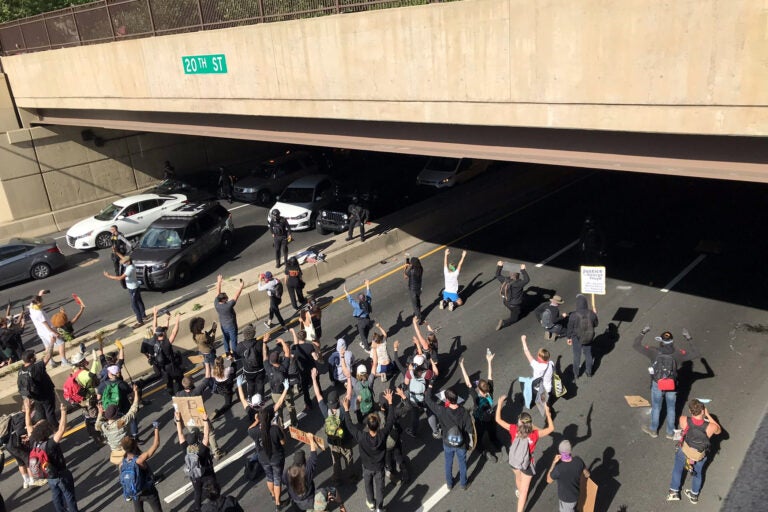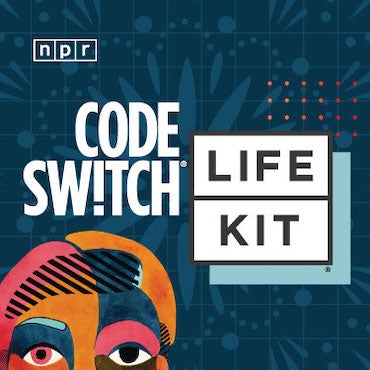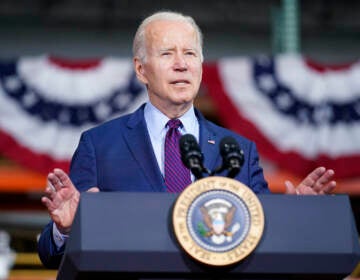‘Why did this just happen?’ Philly’s escalating protests
WHYY reporters chronicle how protests, looting and the police response have escalated in Philly, taking us deep into what they've seen, heard and experienced on the ground.
Listen 34:56
Protesters face off with police during a demonstration on I-676 in Philadelphia on Monday, June 1 (Courtesy of Pilar Goñalons Pons)
It’s now day four since Philadelphia has been rocked by a series of protests that started in Center City on Saturday and has spread to neighborhoods across the city. But what started as a collection of peaceful demonstrations protesting the killing of George Floyd, who died after a Minneapolis police officer knelt on his neck for nearly nine minutes, has given way to escalating vandalism, looting and an increasingly aggressive police response.
WHYY reporters Alan Yu, Ximena Conde, Avi Wolfman-Arent, Miles Bryan and Community Engagement Editor Chris Norris chronicle how we got here, taking us deep into what they’ve seen, heard and experienced on the ground.

Hear the whole story on The Why
Interview highlights
Alan Yu on police officers attempting to control the crowd on Saturday
At this point, they [officers] started forming a wider perimeter and they started cutting off the group into sort of smaller pockets of protesters to try to get them through. And then we were all penned in by these lines of officers. And these are officers that included the Pennsylvania Police Department and also Pennsylvania state troopers … Imagine a fully packed subway car, except that the walls just keep closing in around you … And that’s when it got a little more chaotic.
Ximena Conde on what peaceful protestors are calling for
They were calling for [now-fired police officer] Derek Chauvin to be charged with first-degree murder for the death of George Floyd. They had signs that read “End White Supremacy,” and “We are all humans no matter the color.” One Black protester had a sign that said that asked, ” Am I next?” It was more like a community meeting between speakers and attendees. You could hear the choppers overhead and the occasional police siren. But mostly it was Black speakers sharing their lived experiences.
Avi Wofman-Arent on being arrested while covering a protest near Independence Mall
Then sort of before I knew it, I was face down on the steps, the stone steps, and I was being arrested by an officer. And I told him very clearly, I’m a member of the press. I’m with WHYY. I don’t remember him saying much to me … He put plastic cuffs around my my wrists and then sat me down on the curb with several of the protesters. Basically what the police said is they gave a dispersal warning and that we had disobeyed the dispersal warning … I did not hear a dispersal warning.
Miles Bryan on protesters marching onto I-676
And suddenly we were on the highway, first blocking the the westbound lanes and then blocking both both sides of the highway. And that was the moment that things felt like they had taken a turn into the unknown, the unplanned for. I mean, we were blocking cars that were just driving and stopped. You heard tons of honking. People were screaming. I was looking around trying to capture it and also to see where the police presence was. And we were out there for maybe five minutes, although I don’t have a good sense of time, but it wasn’t long before suddenly I started to hear loud pops, and those pops we now know were tear gas …
I was not up at the very front, so there are things I couldn’t see. That said, I said I didn’t see any protesters or people involved in the march being anything but peaceful. The city of Philadelphia, the chief of police, Danielle Outlaw and Mayor Jim Kenney, put out a statement at like 11:15 p.m. last night that that spoke to their reasoning. And they said that tear gas was used after police forces were pelted with rocks and bottles and one state trooper’s car was was rocked back and forth by protesters and that trooper, you know, had no means of escape. I can’t say for sure whether that did or didn’t happen because I didn’t see with my own eyes. I can tell you that the protesters I spoke with immediately after and it’s sort of feeling the air was, “Why did this just happen?”
Chris Norris on what happens next
Unfortunately, it’s not optimistic … What’s going to mitigate this moment is not reforms. It’s not prayer. It’s not fasting. It’s an actual reexamination and a restructuring of society that acknowledges white racism, white indifference and white privilege and the impact that it has on Black rage. We’re looking at a long, hot summer. You know, if you think about this moment in the context of the long, hot summer of 1967, history is repeating itself and the causes of what we’re seeing in some of these cities and the anger behind what we’re seeing, even if these riots and these looters are not connected to any mainstream organization, the anger and the rage and the indifference to society is indicative of how they feel left out, how they feel disenfranchised, how they don’t feel connected to their community. You know, you always hear, “Why are people burning down their own community?” Well, “community” is an interesting word, and a community doesn’t mean neighborhood. So people are burning down their own neighborhoods, but they’re not necessarily burning down their community because they don’t feel connected to a community.
WHYY is your source for fact-based, in-depth journalism and information. As a nonprofit organization, we rely on financial support from readers like you. Please give today.






